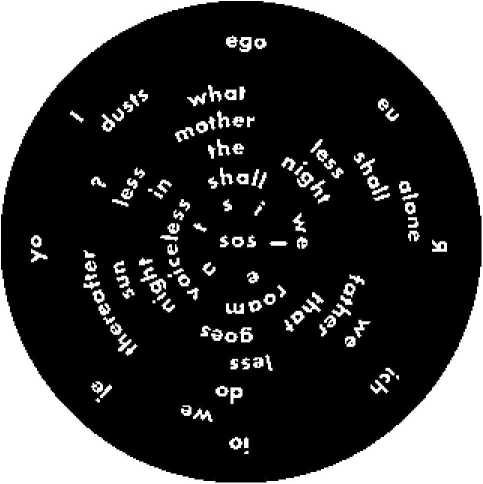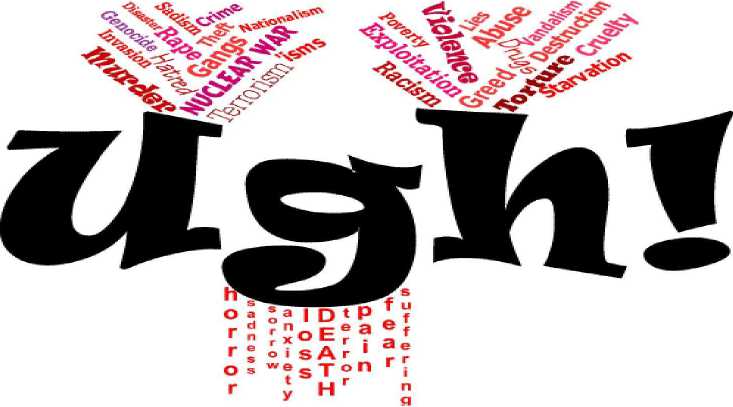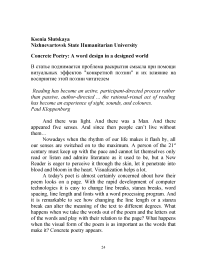Concrete poetry: a word design in a designed world
Автор: Slutskaya Ksenia
Журнал: Тропа. Современная британская литература в российских вузах @footpath
Рубрика: Essays on literary topics
Статья в выпуске: 1, 2008 года.
Бесплатный доступ
The article raises the problem of revealing the meaning with the help of visual effects of "concrete poetry" and their influence on the perception of this poetry by the reader.
Короткий адрес: https://sciup.org/147230477
IDR: 147230477
Текст научной статьи Concrete poetry: a word design in a designed world
And there was light. And there was a Man. And there appeared five senses. And since then people can’t live without them...
Nowadays when the rhythm of our life makes it flash by, all our senses are switched on to the maximum. A person of the 21st century must keep up with the pace and cannot let themselves only read or listen and admire literature as it used to be, but a New Reader is eager to perceive it through the skin, let it penetrate into blood and bloom in the heart. Visualization helps a lot.
A today's poet is almost certainly concerned about how their poem looks on a page. With the rapid development of computer technologies it is easy to change line breaks, stanza breaks, word spacing, line length and fonts with a word processing program. And it is remarkable to see how changing the line length or a stanza break can alter the meaning of the text to different degrees. What happens when we take the words out of the poem and the letters out of the words and play with their relation to the page? What happens when the visual form of the poem is as important as the words that make it? Concrete poetry appears.
Many scholars are so pessimistic and skeptical about it that Concrete poetry becomes less and less popular with ordinary readers, disproving even the fact that being stylistically charged, pieces of Concrete poetry are thought provoking and presuppose a great development of mind and thought of both the poet and the reader; because if they cooperate, influence each other, create the atmosphere of a mental conflict and battle, only then a new idea will be born. Everyone can become a witness of this process. It’s no secret that the poem is not only the poet’s view of the world embodied in means of the language (that is the words) and put down on paper, but also the creation the aim of which is to appeal to the reader. Sometimes such an appeal is clearly seen (or heard) through the words of the poem, but in many poems including practically all visual ones the reader should actively participate to reveal the sense of it. Thus concrete poem challenges the creativity of the reader, on condition that you are not afraid of making up suggestions, putting forward the ideas and let your imagination fly through your experience.
Once we tried while reading Michael P. Garofalo’s poems. He is an American poet, but it’s not his main occupation. Michael is a versatile person: a semi-retired librarian, public administrator and teacher. His personal interests and hobbies include: gardening and landscaping at his home, fitness and sports activities, developing Internet web sites, walking adventures, poetry , research and writing, string figures . computer software, natural history, graphical arts, music, etc. He work s part-time for the Corning Union Elementary School District , and teaches yoga at the Tehama Family Fitness Center .
The author is known for his gloomy and depressing spirit of poems, but usually he shows the truth of life in his works, making the reader face the reality. Though sometimes we do need such an “excursion” to our real world, but do we need the whole truth? His “Crying eyes in a mirror” gives us a chance to find the answer.
The Whole Truth 5 The Whole Truth 5
£ The Whole Truth
The Whole Truth Ф
The Whole Truth
Ф'
Half Truths UI £ E h-1
empty 2 5
truths ф 5
§ The Whole Truth fl) The Whole Truth

E fl>
Я 7 от
pThe Whole Truth $
I I Half Truths
The Whole Truth ^>№<<»6
ф e ^^ / 5
V^t 4^V
crying Sni^ eyes еэ^э In а в ni mirror lonim
Michael P. Garofalo, “Crying eyes in a mirror”
The poem is read from the right hand corner where the reader finds a shape of a door. So we enter the poem through the door of “empty truth”- some unproved, based-on-nothing rumors, disconnected phrases you usually hear from people you don’t actually know. Then the obstacle on the way to “the truth” is “half truths” which is definitely unpleasant (and the black colour intensifies the effect) as no one wants to know only half of the Truth. That is why instinctively we move further and reach “The Whole Truth” in the shape of a filled, no-escape rectangle. However it is not a secret that the Truth hurts and this idea is presented by the author in a form of a sword which is piercing the rectangle. Red colour, being a spike, signals the pain caused by the Truth. After this the perceiver of the Truth can only hear separate words, phrases, which are actually “the cold, hard facts”. By the form of a circle Michael P. Garofalo shows perpetual situation, doom, vicious circle. And again red circumference symbolizes pain, which results in two crying eyes red from tears in a mirror.
In this poem the author managed not only to convey an eternal truth of people’s reaction to the Truth, to present the procedure of receiving it, but also to make a diagnosis for the whole humanity:
the truth hurts.
Another illustrative example of the theme of an inevitability can be found in the work of Augusto de Campos (a Brazilian writer who with his brother Haroldo de Campos was a founder of the Concrete poetry movement in Brazil. He is also a translator, music critic and visual artist) “SOS”:

Augusto de Campos, “SOS”
The reader starts observing the poetry from the center of the circle, which reveals the title of the piece. The words of the poem are placed in such a way as to make chaos, which resembles the one the Universe was made up from. The black background contributes to the association with space - cold, shapeless and colourless.
And as soon as you start reading these words, you get involved in whirling. It is quite strange as the poem is not kinetic but it moves! The faster you read the quicker it whirls. It seems as if it were throbbing in the mind thus asking for help. The words seem to be like atoms of one molecule which is more alive than dead. Interestingly enough the closer these atoms come to the end of the circle, the more separated they become. What is more interesting about this is that these atoms of the last circumference represent nothing but the pronoun “I” in different languages. The reader immediately understands the critical state of the situation as it is visually presented that if there is not any help, the world will be parted, all people of different nationalities will be separated into uncoordinated “I”s. Colour adds to the effect: yellow does not always represent the sun, more often this is the colour of despair, disorder (physical or mental) and other states which produce negative effect on people.
The colour helps a lot in the realization of the meaning of the poem: black represents the Universe and yellow words resemble constellations, but if we regard the whole poem as a unity while reading, those constellations turn into the space dust or very small shining pieces which are slightly dissolving in the Universe.
For every poet it is very natural to touch upon questions which remain topical throughout the time: life and death, happiness and grieve, loneliness, horror etc. In the above mentioned example the doom of loneliness comes to the fore. In the following poem the leading role is devoted to the idea of horror in all its variations and forms. Nowadays horror is creeping closer and closer to every heart penetrating through TV and other mass media into families: images of terrorists and bombs are now not a novelty or fiction, but a part of our cruel reality, which is depicted in the poem “Ugh!” by Michael P. Garofalo. The poet appears to be very productive in “colourful” types, experimenting with usually bright and loud colours.

Michael P. Garofalo, “Ugh!”
The poem itself is read from the first word, actually interjection, ugh. The dictionary gives the meaning of it: “sound... made to indicate disgust or horror”. Not only through the colour (black) and the type face (large) can we guess the meaning, but also from those red words, which are poured into the interjection (crime, sadism, murder, rape, disaster, genocide, invasion, hatred, gangs, nuclear war, gangs, theft, nationalism, racism, exploitation, poverty, violence, lies, abuse, drugs, greed, destruction, torture, cruelty, starvation, vandalism) as if they were meat put into a mincingmachine. The product which comes out of this “machine” is a mixture of horror, sadness, sorrow, anxiety, loss, death, terror, pain, fear and suffering. And if the reader looks at the poem, neglecting the meaning of words, they will have a picture from a scary movie -something bleeding.
By the difference in shades of red colours (from light to dark) of the “incoming product” the author wanted to show that ways of violence are different (he named 27 of it and the list is far from being complete), but the result is always the same, that is why the “out coming product” is depicted in one bloody-red colour.
“Ugh!” is a clear case in point of an inside cry, of what is kept in the soul, masterfully brought to paper. This can prove that in spite of the fact that Concrete poetry, breaking the norms and the rules of literature and approaching avant-garde, is trying to stand apart from literature, it enriches it and serves the main aim of literature - to help people through reading and analysis understand their problems deeply and find the way out.


